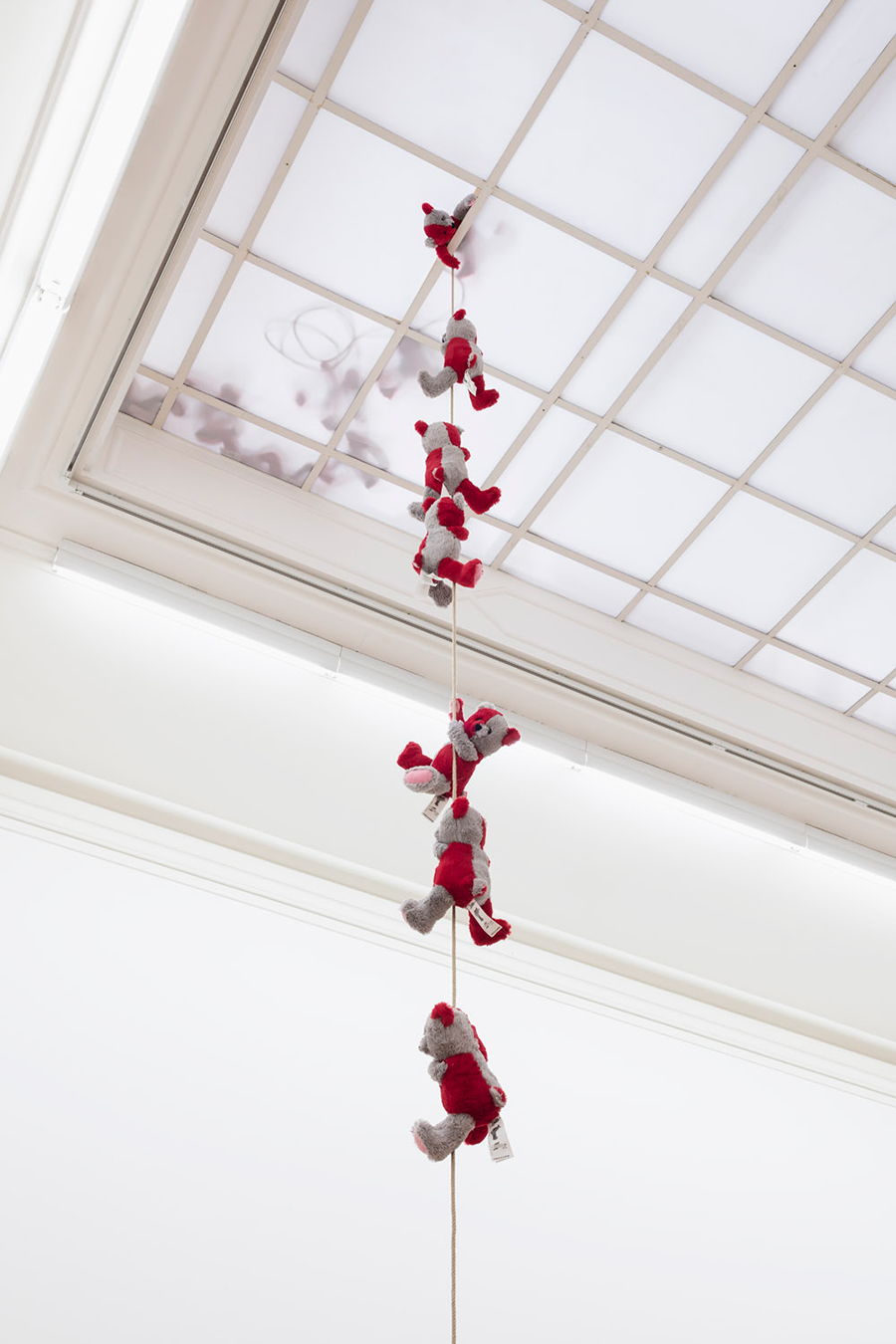Artist Tobias Kaspar’s Harlequin Teddies Embrace the Ambiguities of Consumer Culture
For an exhibition at Kunsthalle Bern, the grey, red and pink toys formed a cute, uncanny parade
For an exhibition at Kunsthalle Bern, the grey, red and pink toys formed a cute, uncanny parade

It rarely happens that visitors to art exhibitions are greeted by 1,000 teddy bears. Yet precisely this unlikely committee assembled at Tobias Kaspar’s solo show ‘Independence’ at the Kunsthalle Bern. The grey, red and pink toys descended from the ceiling and continued in a march formation on the parquet floor – a cute, uncanny parade. Uncanny, because the formation recalled an assembly of the masses typical of totalitarian regimes. However, the teddies could be individually purchased and taken away directly from the exhibition; the more teddies the audience bought, the less totalitarian the formation appeared. Was the artist siding with market enthusiasts? Was he mocking them? As with so many things in this show, there was no clear answer.

Each teddy bear carried the label ‘Tobias Kaspar’. The artist’s name was never mentioned in the press release, nor was it communicated by the Kunsthalle prior to the opening. This double-bind of authorship and branding on the one hand, and critical distancing from the logic of commerce on the other, was a common thread through the exhibition. Kaspar combined recent and older works into a veritable parcours: teddies, large-scale prints depicting close-ups of the Japan-related collection of a textile company from St. Gallen, Switzerland, original scenery from a 2016 Swiss amateur theatre production of One Flew Over the Cuckoo’s Nest, cut-up boots cast in bronze, cosmetic products cast in porcelain and the Japanese robotic pet Aibo (Aibo, 2018).
The bulk of the exhibition related to consumer culture, fashion and the entertainment and lifestyle industries. Bottles of Vitamilk (Vitamilk, 2018), standing on the floor like leftovers from a picnic, seemed to allude to what German philosopher Gernot Boehme has called ‘aesthetic capitalism’: a form of capitalism whose main task no longer is to satisfy basic human needs, but to prompt insatiable desires for vital intensity. The ambiguity of the show culminated in a three-channel video work showing a young woman as she applied beauty cream to her face until an allergic reaction took place. Beautification and uglification appeared as the two sides of the same performative coin: what it is is what you do with it.

Kaspar is a paragon of what could be called an embedded artist. Disenchanted with the myths of the artist as a prophet, hero or sage, yet still an adept of criticality, he dives into the world of consumer culture, even launching a still ongoing blue jeans line. However, he is not comparable to Jeff Koons or Takashi Murakami, who appropriate consumerist aesthetics much more unabashedly. Kaspar’s ambiguous aesthetic is rather one of interestedness in the sense of its Latin roots, ‘inter esse’ – ‘being inbetween’, navigating the boundaries like a trickster, jester or pirate. It is telling, then, Kaspar named the work Harlequin teddies (2018).
Perhaps the easiest work to overlook was a tiny bottle of Chanel perfume that stood on a radiator ledge (Boy, 2018). It was also one of the most important ones. Whereas the assembly of objects contributed to an overall impression of openness, fluidity, pervasiveness and performativity, the flacon, which contained an ephemeral fragrance, remained firmly closed. Andy Warhol wrote in his The Philosophy of Andy Warhol (1975): ‘[A] way to take up more space is with perfume.’ Kaspar, however, chose to take up space with a sprawling parcours of art and almost-art objects, ultimately showing how the air between these objects remained as pure as the air in an art space can be. Maybe this undefined space, within a maelstrom of visual signs, is what ‘independence’ stood for in this show.
Tobias Kaspar, ‘Independence’ was on view at Kunsthalle Bern from 22 September until 2 December 2018.
Main image: Tobias Kaspar, 'Independence', 2018, installation view. Courtesy: Kunsthalle Bern; photograph: Gunnar Meier























